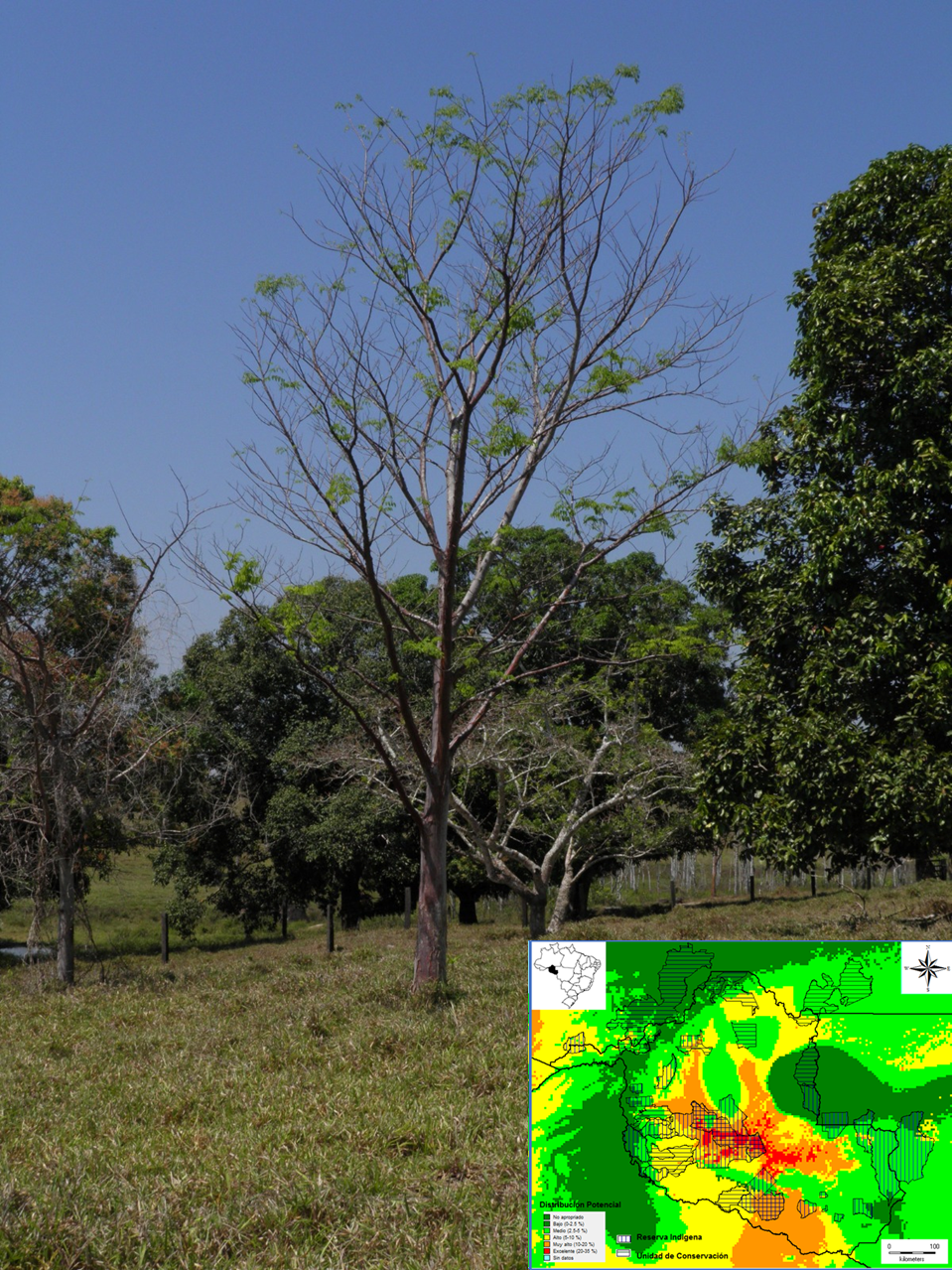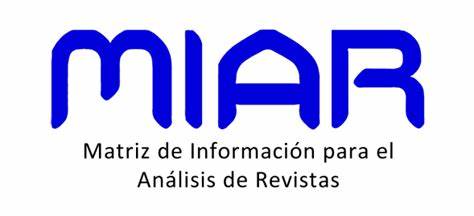Biogeographical distribution, conservation and local use of Amburana acreana (Ducke) A. C. Sm. in the Cacoal-Rondônia region, Brazil
DOI:
https://doi.org/10.54502/msuceva.v3n2a9Palabras clave:
Brazilian Amazon, Deforestation, Habitat destruction, GISResumen
Amburana acreana (Ducke) A. C. Sm., popularly known as "cerejeira" or emburana, is a tree belonging to the Fabaceae family (Leguminosae: Faboideae) and is included in the list of threatened and endangered species, according to Regulation No. 06 of the Brazilian Ministry of the Environment, dated 23 September 2008, standing out as one of the most vulnerable species. The objective of this study was to analyse the biogeographic distribution of A. acreana in the municipality of Cacoal, located in the Brazilian Amazon. The research was based on field data, complemented by herbarium records, databases, sampling and surveys of the local community to obtain information on the location and abundance of the species. The use of advanced tools such as DIVA-GIS 7.5® and Terra-i® made it possible to visualise the distribution of A. acreana in Brazil, both in its natural habitat (States of Acre, Mato Grosso and Rondônia) and in cultivated areas (Minas Gerais and Rio de Janeiro), extending also to Bolivia and Peru. In the municipality of Cacoal, the presence of the species was confirmed in ten localities, two of which hosted more than six adult individuals. The consideration of the microclimatic conditions of these localities proves to be a crucial element for proposing effective conservation strategies. The study not only provides a detailed overview of the distribution of A. acreana, but also highlights the need to address specific environmental conditions to ensure the long-term conservation of this threatened species in the Amazon region.
Descargas
Métricas
Citas
Massari S, De Leo F, Miglietta PP, Ruberti M. Biodiversity. Encyclopedia of Sustainable Management, Cham: Springer International Publishing; 2021, p. 1–4. https://doi.org/10.1007/978-3-030-02006-4_993-1 DOI: https://doi.org/10.1007/978-3-030-02006-4_993-1
Danielson RE, Mazza Rodrigues JL. Impacts of land-use change on soil microbial communities and their function in the Amazon Rainforest. Advances in Agronomy 2022; 175:179–258. https://doi.org/10.1016/bs.agron.2022.04.001 DOI: https://doi.org/10.1016/bs.agron.2022.04.001
Silva Junior CHL, Pessôa ACM, Carvalho NS, Reis JBC, Anderson LO, Aragão LEOC. The Brazilian Amazon deforestation rate in 2020 is the greatest of the decade. Nat Ecol Evol 2020;5:144–5. https://doi.org/10.1038/s41559-020-01368-x DOI: https://doi.org/10.1038/s41559-020-01368-x
Ministério do Meio Ambiente-MMA. Instrução normativa No.6, de 23 de setembro de 2008.
http://cncflora.jbrj.gov.br/portal/static/pdf/documentos/Instrucao_Normati.pdf.
Seleme EP, Lewis GP, Stirton CH, Sartori ÂL b., Mansano VF. A taxonomic review and a new species of the South American woody genus Amburana (Leguminosae, Papilionoideae); Phytotaxa 2015;212:249. https://doi.org/10.11646/phytotaxa.212.4.1 DOI: https://doi.org/10.11646/phytotaxa.212.4.1
Silveira Z de S, Macêdo NS, Bezerra SR, Siyadatpanah A, Coutinho HDM, Seifi Z, et al. Phytochemistry and Biological Activities of Amburana cearensis (Allemão) ACSm. Molecules 2022; 27:505. https://doi.org/10.3390/molecules27020505 DOI: https://doi.org/10.3390/molecules27020505
Leite EJ. State-of-knowledge on Amburana cearensis (Fr. Allem.) A.C. Smith (Leguminosae: Papilionoideae) for genetic conservation in Brazil. J Nat Conserv 2005; 13:49–65. https://doi.org/10.1016/j.jnc.2004.07.003 DOI: https://doi.org/10.1016/j.jnc.2004.07.003
Empresa Brasileira de Pesquisa Agropecuária Embrapa Florestas-EMBRAPA. Cerejeira-da-Amazônia Amburana acreana. Florestas, Brasil: 2008. https://www.infoteca.cnptia.embrapa.br/bitstream/doc/315108/1/Doc170.pdf.
Veloso H, Rangel F, Alves LJC. Classificação da vegetação brasileira adaptada a um sistema universal. Ministerio da Economia, Fazenda E Planejamento Fundação Instituto Brasileiro de Geografia e Estatistica – IBGE Diretoria De Geociências. Departamento de recursos naturais e estudos ambientais. Rio de Janeiro, Brasil: 1991.
https://www.jbb.ibict.br/bitstream/1/397/1/1991_classificacaovegetal_Velloso1991.pdf.
Instituto Brasileiro de geografía e Estatistica-IBGE. Mapa exploratório de solos, Pedología. Estado de Rondônia. Rondônia, Brasil: 2006. https://geoftp.ibge.gov.br/informacoes_ambientais/pedologia/vetores/brasil_5000_mil/
Ocampo J, Coppens D’Eeckenbrugge G, Jarvis A. Distribution of the Genus Passiflora L. Diversity in Colombia and Its Potential as an Indicator for Biodiversity Management in the Coffee Growing Zone. Diversity (Basel) 2010; 2:1158–80. https://doi.org/10.3390/d2111158 DOI: https://doi.org/10.3390/d2111158
Tang X, Bullock EL, Olofsson P, Estel S, Woodcock CE. Near real-time monitoring of tropical forest disturbance: New algorithms and assessment framework. Remote Sens Environ 2019; 224:202–18. https://doi.org/10.1016/j.rse.2019.02.003 DOI: https://doi.org/10.1016/j.rse.2019.02.003
Reger B, Häring T, Ewald J. The TRM model of potential natural vegetation in mountain forests. Folia Geobot 2014; 49:337–59. https://doi.org/10.1007/s12224-013-9158-0 DOI: https://doi.org/10.1007/s12224-013-9158-0
Rajjou L, Duval M, Gallardo K, Catusse J, Bally J, Job C, et al. Seed Germination and Vigor. Annu Rev Plant Biol 2012; 63:507–33. https://doi.org/10.1146/annurev-arplant-042811-105550 DOI: https://doi.org/10.1146/annurev-arplant-042811-105550
Barber CP, Cochrane MA, Souza CM, Laurance WF. Roads, deforestation, and the mitigating effect of protected areas in the Amazon. Biol Conserv 2014; 177:203–9. https://doi.org/10.1016/j.biocon.2014.07.004 DOI: https://doi.org/10.1016/j.biocon.2014.07.004
Braz EM, Thaines F, Mattos PP de, Oliveira LC, Ribas LA, D’Oliveira MVN, et al. Management of Amburana cearensis; var. Acreana; In Acre State, Brazil. Ciência Florestal 2014; 24:455–63. https://doi.org/10.5902/1980509814586 DOI: https://doi.org/10.5902/1980509814586
Fois M, Cuena-Lombraña A, Fenu G, Bacchetta G. Using species distribution models at local scale to guide the search of poorly known species: Review, methodological issues and future directions. Ecol Modell 2018; 385:124–32. https://doi.org/10.1016/j.ecolmodel.2018.07.018 DOI: https://doi.org/10.1016/j.ecolmodel.2018.07.018
Global Forest Watch. Rondônia, Brasil. Cubierta terrestre, cambio forestal, incendios y clima. Pérdida del bosque primario en Rondônia, Brasil 2023. https://www.globalforestwatch.org/dashboards/country/BRA/22/?category=forest-change&location=WyJjb3VudHJ5IiwiQlJBIiwiMjIiXQ%3D%3D
Pedlowski MA, Dale VH, Matricardi EAT, da Silva Filho EP. Patterns and impacts of deforestation in Rondônia, Brazil. Landsc Urban Plan 1997; 38:149–57. https://doi.org/10.1016/S0169-2046(97)00030-3 DOI: https://doi.org/10.1016/S0169-2046(97)00030-3
Bento GP, Schmitt Filho AL, Faita MR. Sistemas silvipastoris no Brasil: Uma revisão sistemática. Research, Society and Development 2020;9: e7019109016. https://doi.org/10.33448/rsd-v9i10.9016 DOI: https://doi.org/10.33448/rsd-v9i10.9016
Sandoval DF, Florez JF, Enciso Valencia KJ, Sotelo Cabrera ME, Stefan B. Economic-environmental assessment of silvo-pastoral systems in Colombia: An ecosystem service perspective. Heliyon 2023;9: e19082. https://doi.org/10.1016/j.heliyon.2023.e19082 DOI: https://doi.org/10.1016/j.heliyon.2023.e19082
Hanson J, Ellis R. Progress and challenges in ex situ conservation of forage germplasm: Grasses, herbaceous legumes and fodder trees. Plants 2020; 9:446. https://doi.org/10.3390/plants9040446 DOI: https://doi.org/10.3390/plants9040446
Caetano N. DG, Rodrigues de Almeida E, Gómez Carabalí (QEPD) A, Chávez-Servia JL, Otero JT. Patrones de manejo de agroecosistemas deforestados y estrategias de vida de fincas amazónicas de Cacoal, Brasil. Acta Agron 2023; 71:7–13. https://doi.org/10.15446/acag.v71n1.101667 DOI: https://doi.org/10.15446/acag.v71n1.101667
Le Tourneau F-M. The sustainability challenges of indigenous territories in Brazil’s Amazonia. Curr Opin Environ Sustain 2015;14:213–20. https://doi.org/10.1016/j.cosust.2015.07.017 DOI: https://doi.org/10.1016/j.cosust.2015.07.017
Jamison S, Bocca R. Balancing economic growth and the environment: Lessons from Brazil. Energy Transition 2021. https://www.weforum.org/agenda/2021/03/balancing-economic-growth-with-sustainability-lessons-from-brazil/
Ministério do Meio Ambiente. Gov.br. Flona do Bom Futuro. Instituto Chico Mendes de Conservação Da Biodiversidade 2022. https://www.gov.br/icmbio/pt-br/assuntos/biodiversidade/unidade-de-conservacao/unidades-de-biomas/amazonia/lista-de-ucs/flona-do-bom-futuro
Recanati F, Allievi F, Scaccabarozzi G, Espinosa T, Dotelli G, Saini M. Global meat consumption trends and local deforestation in Madre de Dios: Assessing land use changes and other environmental impacts. Procedia Eng 2015;118:630–8. https://doi.org/10.1016/j.proeng.2015.08.496 DOI: https://doi.org/10.1016/j.proeng.2015.08.496
Montero-de-Oliveira F-E, Blundo-Canto G, Ezzine-de-Blas D. Under what conditions do payments for environmental services enable forest conservation in the Amazon? A realist synthesis. Ecological Economics 2023; 205:107697. https://doi.org/10.1016/j.ecolecon.2022.107697 DOI: https://doi.org/10.1016/j.ecolecon.2022.107697
Resende FM, Cimon-Morin J, Poulin M, Meyer L, Joner DC, Loyola R. The importance of protected areas and Indigenous lands in securing ecosystem services and biodiversity in the Cerrado. Ecosyst Serv 2021; 49:101282. https://doi.org/10.1016/j.ecoser.2021.101282 DOI: https://doi.org/10.1016/j.ecoser.2021.101282
Annesi N, Battaglia M, Gragnani P, Iraldo F. Integrating the 2030 Agenda at the municipal level: Multilevel pressures and institutional shift. Land Use Policy 2021; 105:105424. https://doi.org/10.1016/j.landusepol.2021.105424 DOI: https://doi.org/10.1016/j.landusepol.2021.105424
Santiago-Ramos J, Hurtado-Rodríguez C. Assessing Ecosystem Services Provision as a Support for Metropolitan Green Infrastructure Planning: The Case of Three Spanish Metropolitan Areas. Appl Spat Anal Policy 2022; 15:1115–41. https://doi.org/10.1007/s12061-022-09441-7 DOI: https://doi.org/10.1007/s12061-022-09441-7
Peña-Claros M, Nobre C. A regional approach to save the Amazon. Science (1979) 2023; 381:1261–1261. https://doi.org/10.1126/science.adk8794 DOI: https://doi.org/10.1126/science.adk8794

Descargas
Publicado
Cómo citar
Número
Sección
Licencia
Derechos de autor 2023 Cartano Nunes et al.

Esta obra está bajo una licencia internacional Creative Commons Atribución-NoComercial-SinDerivadas 4.0.
Magna Scientia UCEVA proporciona un acceso abierto, libre y gratuito a su contenido, basado en el principio de que ofrecer al público un acceso libre a las investigaciones, ayuda a un mayor intercambio global del conocimiento. Lo cual, implica que los usuarios pueden leer, descargar, almacenar, imprimir, buscar, indexar y realizar enlaces a los textos completos de esta revista. Se permite distribuir los diversos artículos en las versiones post-print y oficial, sin previo permiso del autor o editor, considerando que el fin de este, no implica fines comerciales, ni la generación de obras derivadas; Solo se solicita la mención de la fuente así como la autoría. El titular del copyright será el o los autores que publiquen en Magna Scientia UCEVA.
Magna Scientia UCEVA está distribuida bajo los términos de la licencia https://creativecommons.org/licenses/by-nc-nd/4.0/deed.es




















